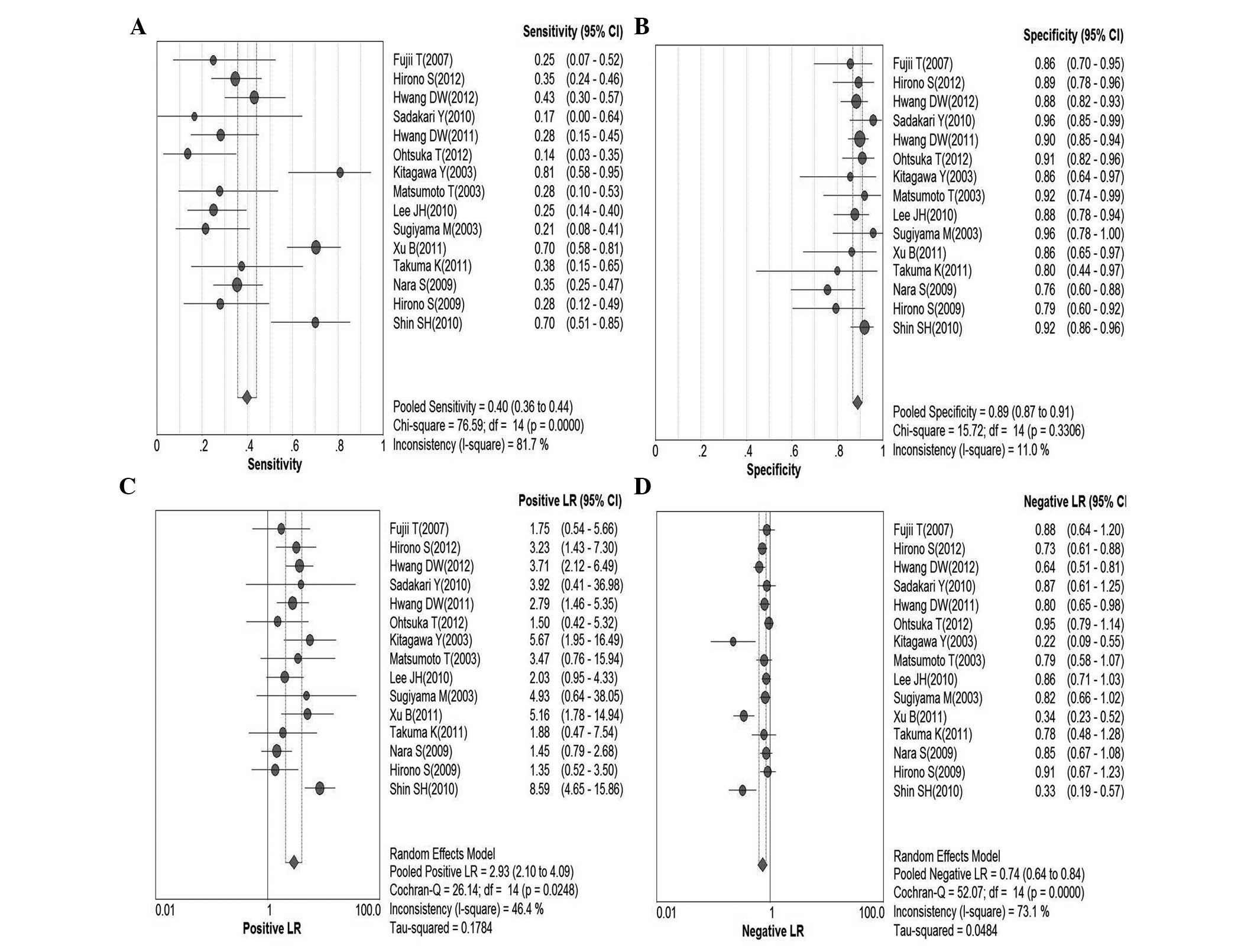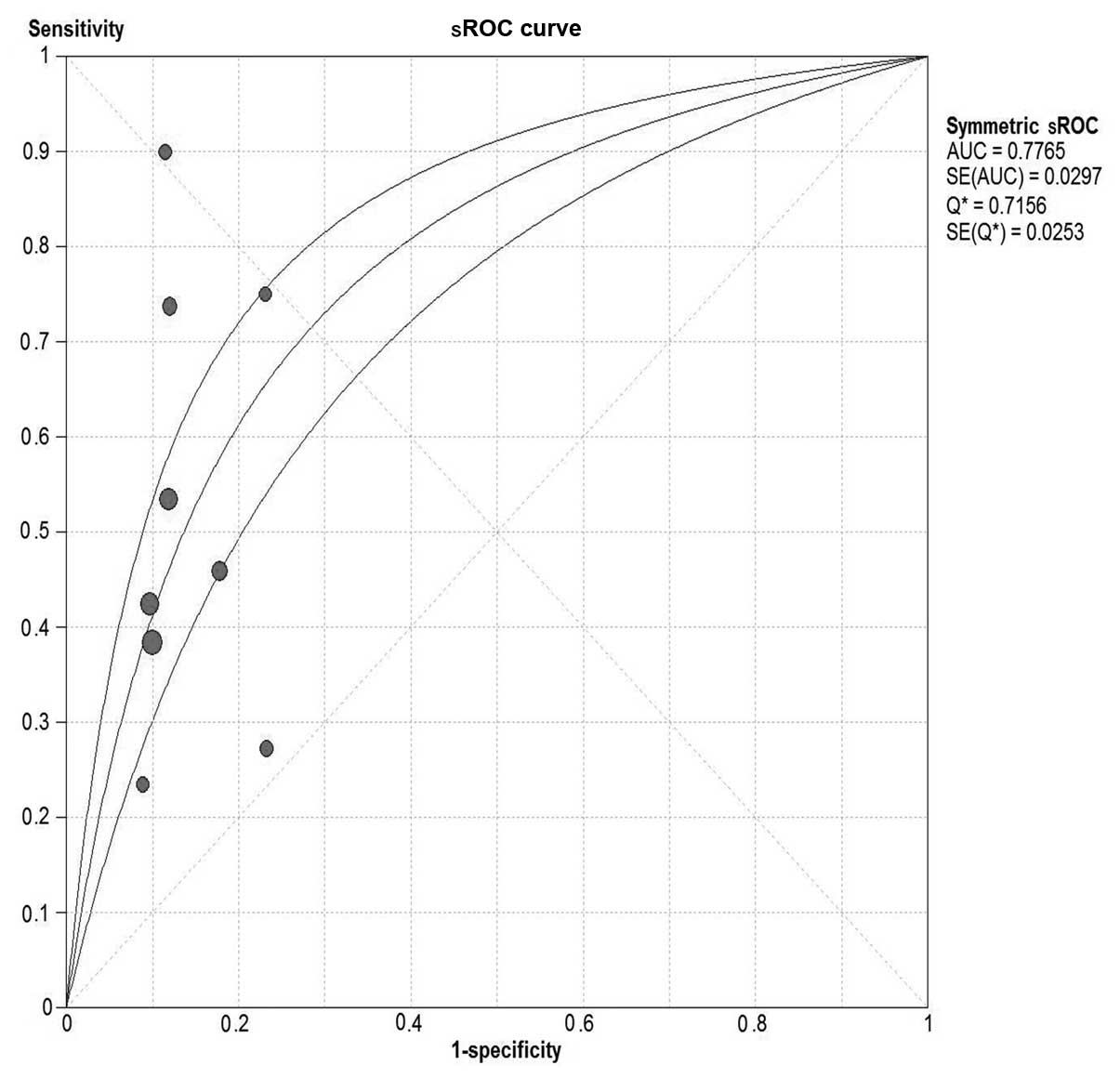|
1
|
Kloppel G, Solcia E, Longnecker DS,
Capella C and Sobin LH: Histological Typing of Tumours of the
Exocrine Pancreas. 2nd. Springer-Verlag; Berlin-Heidelberg: pp.
1–61. 1996, View Article : Google Scholar
|
|
2
|
Hamilton SR and Aaltonen LA: Pathology and
Genetics of Tumours of the Digestive System. IARC Press; Lyon: pp.
237–241. 2000
|
|
3
|
Serikawa M, Sasaki T, Fujimoto Y, Kuwahara
K and Chayama K: Management of intraductal papillary-mucinous
neoplasm of the pancreas: treatment strategy based on morphologic
classification. J Clin Gastroenterol. 40:856–862. 2006. View Article : Google Scholar
|
|
4
|
Yamaguchi K, Nakamura M, Shirahane K, et
al: Pancreatic juice cytology in IPMN of the pancreas.
Pancreatology. 5:416–421. 2005. View Article : Google Scholar : PubMed/NCBI
|
|
5
|
Tanaka M, Kobayashi K, Mizumoto K and
Yamaguchi K: Clinical aspects of intraductal papillary mucinous
neoplasm of the pancreas. J Gastroenterol. 40:669–675. 2005.
View Article : Google Scholar : PubMed/NCBI
|
|
6
|
Shimizu Y, Kanemitsu Y, Sano T, Senda Y,
Mizuno N and Yamao K: A nomogram for predicting the probability of
carcinoma in patients with intraductal papillary-mucinous neoplasm.
World J Surg. 34:2932–2938. 2010. View Article : Google Scholar
|
|
7
|
Kimura W, Sasahira N, Yoshikawa T, Muto T
and Makuuchi M: Duct-ectatic type of mucin producing tumor of the
pancreas - new concept of pancreatic neoplasia.
Hepatogastroenterology. 43:692–709. 1996.PubMed/NCBI
|
|
8
|
Sai JK, Suyama M, Kubokawa Y, et al:
Management of branch duct-type intraductal papillary mucinous tumor
of the pancreas based on magnetic resonance imaging. Abdom Imaging.
28:694–699. 2003. View Article : Google Scholar : PubMed/NCBI
|
|
9
|
Sugiyama M, Izumisato Y, Abe N, Masaki T,
Mori T and Atomi Y: Predictive factors for malignancy in
intraductal papillary-mucinous tumours of the pancreas. Br J Surg.
90:1244–1249. 2003. View
Article : Google Scholar : PubMed/NCBI
|
|
10
|
Schmidt CM, White PB, Waters JA, et al:
Intraductal papillary mucinous neoplasms: predictors of malignant
and invasive pathology. Ann Surg. 246:644–654. 2007. View Article : Google Scholar : PubMed/NCBI
|
|
11
|
Maire F, Voitot H, Aubert A, et al:
Intraductal papillary mucinous neoplasms of the pancreas:
performance of pancreatic fluid analysis for positive diagnosis and
the prediction of malignancy. Am J Gastroenterol. 103:2871–2877.
2008. View Article : Google Scholar : PubMed/NCBI
|
|
12
|
Fritz S, Hackert T, Hinz U, Hartwig W,
Buchler MW and Werner J: Role of serum carbohydrate antigen 19-9
and carcinoembryonic antigen in distinguishing between benign and
invasive intraductal papillary mucinous neoplasm of the pancreas.
Br J Surg. 98:104–110. 2011. View
Article : Google Scholar
|
|
13
|
Hartwig W, Schneider L, Diener MK,
Bergmann F, Buchler MW and Werner J: Preoperative tissue diagnosis
for tumours of the pancreas. Br J Surg. 96:5–20. 2009. View Article : Google Scholar
|
|
14
|
Pais SA, Attasaranya S, Leblanc JK,
Sherman S, Schmidt CM and DeWitt J: Role of endoscopic ultrasound
in the diagnosis of intraductal papillary mucinous neoplasms:
correlation with surgical histopathology. Clin Gastroenterol
Hepatol. 5:489–495. 2007. View Article : Google Scholar : PubMed/NCBI
|
|
15
|
Ferrone CR, Finkelstein DM, Thayer SP,
Muzikansky A, Fernandez-delCastillo C and Warshaw AL: Perioperative
CA19-9 levels can predict stage and survival in patients with
resectable pancreatic adenocarcinoma. J Clin Oncol. 24:2897–2902.
2006. View Article : Google Scholar
|
|
16
|
Sandblom G, Granroth S and Rasmussen IC:
TPS, CA 19-9, VEGF-A, and CEA as diagnostic and prognostic factors
in patients with mass lesions in the pancreatic head. Ups J Med
Sci. 113:57–64. 2008. View Article : Google Scholar : PubMed/NCBI
|
|
17
|
Smith RA, Bosonnet L, Ghaneh P, et al:
Preoperative CA19-9 levels and lymph node ratio are independent
predictors of survival in patients with resected pancreatic ductal
adenocarcinoma. Dig Surg. 25:226–232. 2008. View Article : Google Scholar : PubMed/NCBI
|
|
18
|
Zamora J, Abraira V, Muriel A, Khan K and
Coomarasamy A: Meta-DiSc: a software for meta-analysis of test
accuracy data. BMC Med Res Methodol. 6:312006. View Article : Google Scholar : PubMed/NCBI
|
|
19
|
Ohtsuka T, Kono H, Nagayoshi Y, et al: An
increase in the number of predictive factors augments the
likelihood of malignancy in branch duct intraductal papillary
mucinous neoplasm of the pancreas. Surgery. 151:76–83. 2012.
View Article : Google Scholar : PubMed/NCBI
|
|
20
|
Hwang DW, Jang JY, Lee SE, Lim CS, Lee KU
and Kim SW: Clinicopathologic analysis of surgically proven
intraductal papillary mucinous neoplasms of the pancreas in SNUH: a
15-year experience at a single academic institution. Langenbecks
Arch Surg. 397:93–102. 2012.
|
|
21
|
Hirono S, Tani M, Kawai M, et al: The
carcinoembryonic antigen level in pancreatic juice and mural nodule
size are predictors of malignancy for branch duct type intraductal
papillary mucinous neoplasms of the pancreas. Ann Surg.
255:517–522. 2012. View Article : Google Scholar : PubMed/NCBI
|
|
22
|
Xu B, Zheng WY, Jin DY, Ding WX, Lou WH
and Ramsohok L: Predictive value of serum carbohydrate antigen 19-9
in malignant intraductal papillary mucinous neoplasms. World J
Surg. 35:1103–1109. 2011. View Article : Google Scholar : PubMed/NCBI
|
|
23
|
Takuma K, Kamisawa T, Anjiki H, et al:
Predictors of malignancy and natural history of main-duct
intraductal papillary mucinous neoplasms of the pancreas. Pancreas.
40:371–375. 2011. View Article : Google Scholar : PubMed/NCBI
|
|
24
|
Hwang DW, Jang JY, Lim CS, et al:
Determination of malignant and invasive predictors in branch duct
type intraductal papillary mucinous neoplasms of the pancreas: a
suggested scoring formula. J Korean Med Sci. 26:740–746. 2011.
View Article : Google Scholar : PubMed/NCBI
|
|
25
|
Shin SH, Han DJ, Park KT, Kim YH, Park JB
and Kim SC: Validating a simple scoring system to predict
malignancy and invasiveness of intraductal papillary mucinous
neoplasms of the pancreas. World J Surg. 34:776–783. 2010.
View Article : Google Scholar : PubMed/NCBI
|
|
26
|
Sadakari Y, Ienaga J, Kobayashi K, et al:
Cyst size indicates malignant transformation in branch duct
intraductal papillary mucinous neoplasm of the pancreas without
mural nodules. Pancreas. 39:232–236. 2010. View Article : Google Scholar
|
|
27
|
Lee JH, Lee KT, Park J, et al: Predictive
factors associated with malignancy of intraductal papillary
mucinous pancreatic neoplasms. World J Gastroenterol. 16:5353–5358.
2010. View Article : Google Scholar : PubMed/NCBI
|
|
28
|
Nara S, Onaya H, Hiraoka N, et al:
Preoperative evaluation of invasive and noninvasive intraductal
papillary-mucinous neoplasms of the pancreas: clinical,
radiological, and pathological analysis of 123 cases. Pancreas.
38:8–16. 2009. View Article : Google Scholar
|
|
29
|
Hirono S, Tani M, Kawai M, et al:
Treatment strategy for intraductal papillary mucinous neoplasm of
the pancreas based on malignant predictive factors. Arch Surg.
144:345–350. 2009. View Article : Google Scholar : PubMed/NCBI
|
|
30
|
Fujii T, Ishikawa T, Kanazumi N, et al:
Analysis of clinicopathological features and predictors of
malignancy in intraductal papillary mucinous neoplasms of the
pancreas. Hepatogastroenterology. 54:272–277. 2007.PubMed/NCBI
|
|
31
|
Matsumoto T, Aramaki M, Yada K, et al:
Optimal management of the branch duct type intraductal papillary
mucinous neoplasms of the pancreas. J Clin Gastroenterol.
36:261–265. 2003. View Article : Google Scholar : PubMed/NCBI
|
|
32
|
Kitagawa Y, Unger TA, Taylor S, Kozarek RA
and Traverso LW: Mucus is a predictor of better prognosis and
survival in patients with intraductal papillary mucinous tumor of
the pancreas. J Gastrointest Surg. 7:12–19. 2003. View Article : Google Scholar : PubMed/NCBI
|
|
33
|
Katz MH, Varadhachary GR, Fleming JB, et
al: Serum CA 19-9 as a marker of resectability and survival in
patients with potentially resectable pancreatic cancer treated with
neoadjuvant chemoradiation. Ann Surg Oncol. 17:1794–1801. 2010.
View Article : Google Scholar : PubMed/NCBI
|
|
34
|
Sedlack R, Affi A, Vazquez-Sequeiros E,
Norton ID, Clain JE and Wiersema MJ: Utility of EUS in the
evaluation of cystic pancreatic lesions. Gastrointest Endosc.
56:543–547. 2002. View Article : Google Scholar : PubMed/NCBI
|
|
35
|
Tatsuta M, Iishi H, Ichii M, et al: Values
of carcinoembryonic antigen, elastase 1, and carbohydrate antigen
determinant in aspirated pancreatic cystic fluid in the diagnosis
of cysts of the pancreas. Cancer. 57:1836–1839. 1986. View Article : Google Scholar : PubMed/NCBI
|
|
36
|
Satake K, Kanazawa G, Kho I, Chung Y and
Umeyama K: Evaluation of serum pancreatic enzymes, carbohydrate
antigen 19-9, and carcinoembryonic antigen in various pancreatic
diseases. Am J Gastroenterol. 80:630–636. 1985.PubMed/NCBI
|
|
37
|
Ngamruengphong S, Bartel MJ and Raimondo
M: Cyst carcinoembryonic antigen in differentiating pancreatic
cysts: a meta-analysis. Dig Liver Dis. 45:920–926. 2013. View Article : Google Scholar : PubMed/NCBI
|
|
38
|
Othman MO, Patel M, Dabizzi E, et al:
Carcino Embryonic Antigen and long-term follow-up of mucinous
pancreatic cysts including intraductal papillary mucinous neoplasm.
Dig Liver Dis. 44:844–848. 2012. View Article : Google Scholar : PubMed/NCBI
|
|
39
|
Correa-Gallego C, Warshaw AL and
Fernandez-del Castillo C: Fluid CEA in IPMNs: A useful test or the
flip of a coin? Am J Gastroenterol. 104:796–797. 2009. View Article : Google Scholar : PubMed/NCBI
|
|
40
|
Park WG, Mascarenhas R, Palaez-Luna M, et
al: Diagnostic performance of cyst fluid carcinoembryonic antigen
and amylase in histologically confirmed pancreatic cysts. Pancreas.
40:42–45. 2011. View Article : Google Scholar : PubMed/NCBI
|
|
41
|
Nagula S, Kennedy T, Schattner MA, et al:
Evaluation of cyst fluid CEA analysis in the diagnosis of mucinous
cysts of the pancreas. J Gastrointest Surg. 14:1997–2003. 2010.
View Article : Google Scholar : PubMed/NCBI
|
|
42
|
Safi F, Schlosser W, Falkenreck S and
Beger HG: Prognostic value of CA 19-9 serum course in pancreatic
cancer. Hepatogastroenterology. 45:253–259. 1998.PubMed/NCBI
|



















